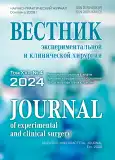Analysis of the Effectiveness of Surgical Treatment of Benign Epithelial Esophageal Neoplasms under Control of Magnifying Chromoendoscopy
- 作者: Himina I.N.1, Trifanov A.N.1, Razinkin K.A.2, Himin N.P.3, Volozhin G.A.3, Ostrovskaya I.G.3, Minchenko Y.V.4
-
隶属关系:
- Voronezh State Medical University named after N.N. Burdenko
- Voronezh State Technical University
- Russian University of Medicine
- Central District Hospital of Neklinovsky district
- 期: 卷 17, 编号 4 (2024)
- 页面: 172-182
- 栏目: Original articles
- URL: https://bakhtiniada.ru/2070-478X/article/view/273800
- DOI: https://doi.org/10.18499/2070-478X-2024-17-4-172-182
- ID: 273800
如何引用文章
全文:
详细
Relevance. The article presents a study and analysis of the effectiveness of the surgical treatment technique for benign epithelial neoplasms of the esophagus under the control of magnifying chromoendoscopy. Epithelial neoplasms of the esophagus and stomach are frequent diagnostic findings during endoscopic examination of the upper gastrointestinal tract. They are detected in 2% of patients, on average, during esophagogastroduodenoscopy. Notably, tactic of their management is not adequately standardized and often encounters challenges in clinical practice.
The aim of the study was to investigate the prognostic significance of individual macroscopic features that allow the morphological structure of epithelial formations to be determined during gastroscopy.
Methods. The study involved clinical data and analysis of the results of prehospital surgical interventions in patients with benign epithelial neoplasms of the esophagus, who made up the main group. Patients of the control group were exposed to endoscopic investigation and diagnosed using conventional techniques. Statistical analysis of the study results was carried out in two directions, namely: endoscopic and morphological diagnostic parameters and objective data on relapses and bleeding were compared using the nonparametric Mann-Whitney test in the main and control groups; the Spearman rank correlation coefficient was applied to assess the closeness of the statistical relationship between endoscopic diagnostic parameters and morphological criteria in order to evaluate the effectiveness of magnifying chromoendoscopy in the surgical treatment of benign epithelial neoplasms of the esophagus in patients of the main group.
Results. The use of magnifying video endoscopy provides beneficial perspectives for detailed assessment of the mucous membrane of the examined organs. Previously, chromo-endoscopy was used to identify the metaplasized epithelium, the boundaries of precancerous trasformations. However, this staining technique was quite time-consuming; it failed to determine microstructural changes in the lesion area and in the perifocal region with extreme accuracy. Currently,the use of magnifying narrow band imaging endoscopy allows visualizing the smallest changes in the tissue surface, assessing the architectonics of the vascular network in the study area and, most importantly, the prevalence of the pathological focus, which increases not only the level of diagnosis of precancerous changes, but also the effectiveness of endoscopic surgical treatment at the stage of primary health care.
In the control group, the percentage of adverse effects was 77.7% (14 cases) based on the results of 18 polypectomies of epithelial neoplasms. If compared with conventional endoscopic examination, we noted the following advantages of the narrow-band imaging endoscopy with optical magnification in the study of benign epithelial neoplasms of the esophagus: 22 cases of endoscopically detected signs of neoplastic changes in the esophageal mucosa were registered, which were morphologically confirmed in 20 patients, this amounting to 90.9%.
Conclusions. The results of the study can be useful for improving treatment approaches, developing surgical intervention protocols and making more informed clinical decisions.
作者简介
Irina Himina
Voronezh State Medical University named after N.N. Burdenko
编辑信件的主要联系方式.
Email: iri-khimina@yandex.ru
ORCID iD: 0000-0003-3109-1972
M.D., Associate Professor of the Department of Specialized Surgical Disciplines
俄罗斯联邦, VoronezhAndrey Trifanov
Voronezh State Medical University named after N.N. Burdenko
Email: andreytrif@rambler.ru
ORCID iD: 0000-0002-2342-9913
attached person to the Department of Specialized Surgical disciplines
俄罗斯联邦, VoronezhKonstantin Razinkin
Voronezh State Technical University
Email: kostyr@mail.ru
ORCID iD: 0000-0002-2032-3777
SPIN 代码: 8526-0146
Scopus 作者 ID: 6508383606
Doctor of Technical Sciences, Associate Professor, Professor of the Department of Information Security Systems
俄罗斯联邦, VoronezhNelson Himin
Russian University of Medicine
Email: nelson131097@yandex.ru
ORCID iD: 0000-0002-6895-8202
dentist-surgeon, postgraduate student of the Department of Oral Surgery
俄罗斯联邦, MoscowGrigory Volozhin
Russian University of Medicine
Email: greguar@bk.ru
ORCID iD: 0000-0002-0205-2811
SPIN 代码: 3652-3607
Scopus 作者 ID: 1113341
Professor of the Department of Oral Surgery Russian University of Medicine, Chief physician
俄罗斯联邦, MoscowIrina Ostrovskaya
Russian University of Medicine
Email: ostvavir@rambler.ru
ORCID iD: 0000-0001-6788-4945
SPIN 代码: 8296-1280
Scopus 作者 ID: 35337593400
Professor of the Department
俄罗斯联邦, MoscowYuri Minchenko
Central District Hospital of Neklinovsky district
Email: nat.min4enko@yandex.ru
ORCID iD: 0000-0002-2195-444X
surgeon, endoscopist
俄罗斯联邦, Pokrovskoye参考
- Khimina IN, Razinkin KA, Trifanov AN. Minchenko YuV. Khimin NP. Algorithm for Barrett’s esophagus diagnosis based on the magnifying chromoendoscopy results. Rossiiskii zhurnal dokazatel'noi gastroenterologii. 2022; 11(2): 11–20. (in Russ.)
- Drobyazgin EA, Chikinev YuV. Analysis of the immediate results of the use of flexible endoscopy for submucosal neoplasms of the esophagus. Endoscopic surgery2021; 27: 5: 12-18. (in Russ.)
- Ivashkin VT, Maev IV, Trukhmanov AS, Lapina TL, Storonova OA, Zayratiants OV, Dronova OB, Kucheryavyi YuA, Pirogov SS, Sayfutdinov RG, Uspensky YuP, Sheptulin AA, Andreev DN, Rumyantseva DE. Recommendations of the Russian Gastroenterological Association for the diagnosis and treatment of gastroesophageal reflux disease. Russian Journal of Gastroenterology, Hepatology, Coloproctology. 2020;30(4):70-97. (in Russ.)
- Skazatina TV, Tsepelev VL. Endoscopic diagnosis of precancerous diseases of the esophagus. Elektronnoe nauchnoe izdanie «Zabaikal'skii meditsinskii vestnik». 2021; 2: 117-126. (in Russ.)
- Kaibysheva VO, Kashin SV, Karasev AV, Merkulova AO, Krainova EA, Fedorov ED, Shapovalyants SG. Barrett's esophagus: current state of the problem. Dokazatel'naya gastroenterologiya. 2020;9(4):33-54. (in Russ.)
- Khikhlova AO, Olevskaya ER, Dolgushina AI. Prospects for endoscopic treatment of patients with heterotopia of the gastric mucosa in the cervical esophagus (literature review). Moscow surgical journal. 2022;(4):114-123. (in Russ.)
补充文件























